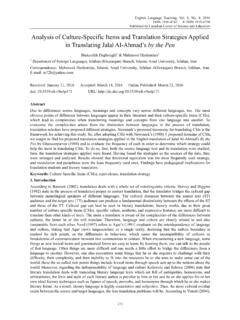Transcription of scaffolding language scaffolding learning
1 scaffolding language scaffolding i8/18/14 8:26 AM8/18/14 8:26 AMPAULINE GIBBONS scaffolding language scaffolding learningTeaching English language Learners in the Mainstream ClassroomSECOND EDITIONHEINEMANNP ortsmouth, iii8/18/14 8:26 AM8/18/14 8:26 AMHeinemann361 Hanover StreetPortsmouth, NH 03801 ces and agents throughout the world 2015 by Pauline GibbonsAll rights reserved. No part of this book may be reproduced in any form or by any electronic or mechanical means, including information storage and retrieval systems, without permission in writing from the publisher, except by a reviewer, who may quote brief passages in a review. Dedicated to Teachers is a trademark of Greenwood Publishing Group, author and publisher wish to thank those who have generously given permission to reprint borrowed material:Figure 1 1: We are grateful to TESOL Italy for permission to reproduce material from Luciano Mariani s article Teacher Support and Teacher Challenge in Promoting Learner Autonomy that was fi rst published in Perspectives: A Journal of TESOL Italy, 1997, 23 (2).
2 Of Congress Cataloging-in-Publication DataGibbons, Pauline. scaffolding language , scaffolding learning : teaching English language learners in the mainstream classroom / Pauline Gibbons. Second edition. pages cm Includes bibliographical references and index. ISBN 978-0-325-05664-7 1. English language Study and teaching Foreign speakers. 2. Interdisciplinary approach in education. 3. Second language acquisition. 4. language and education. I. dc23 2014018174 Editor: Holly Kim PriceProduction: Vicki KasabianCover design: Suzanne HeiserInterior design: Monica Ann CriglerTypesetter: Kim ArneyManufacturing: Steve BernierPrinted in the United States of America on acid-free paper18 17 16 15 14 EBM 1 2 3 4 iv8/18/14 8:26 AM8/18/14 8:26 AMThis book is dedicated to the loved ones who enrich my life: Mark, Ben, Nadia, Safi ya, and Laurie,and in memory of my dear friend and colleague Glynis v8/18/14 8:26 AM8/18/14 8:26 AMCONTENTSACKNOWLEDGMENTS xi 1 scaffolding language and learning 1An Introductory story and Some Implications for Teachers 1EL Learners in the Mainstream Classroom.
3 Some Key Issues 4 Views of Teaching and learning 11An Outline of the Book 19In Summary 21To Think About 21 Suggestions for Further Reading 22 2 Classroom Talk: Creating Contexts for language learning 23 What Helps Learners to Learn a New language ? 24 Classroom Talk and EL Learners 31In Summary 46To Think About 47 Suggestions for Further Reading 47 3 Collaborative Group Work and Second language learning 49 Making Group Work Effective 54 Some Suggestions for Group and Pair Activities Across the Curriculum 64 Activities Especially for Beginners 71 Developing and Maintaining Relationships 74In Summary 76To Think About 77 Suggestions for Further Reading 77 4 From Speaking to Writing in the Content Classroom 79 Using the Mode Continuum: From Speaking to Writing 80 Some Implications for the Classroom 92In Summary 94To Think About 94 Suggestions for Further Reading vii8/18/14 8:26 AM8/18/14 8:26 AMviii 5 learning to Write in a Second language and Culture 96 Some Challenges for EL Learners 97 What Is a Genre?
4 98 The Genres of School 102 Explicit Teaching About Writing 108 The Teaching and learning Cycle 109 Additional scaffolding for Young Learners and EL Beginners 121A Scaffolded Approach to Writing 125 Assessing Students Writing: What Their Texts Can Tell Us 126In Summary 133To Think About 134 Suggestions for Further Reading 134 6 Reading in a Second language and Culture: Barriers and Bridges 135 The Process of Reading 136 Reader Roles 140 Implications for EL Learners 143 Developing Phonemic Awareness: How Listening and Reading Interact 169 Building on Phonemic Awareness: Developing Phonic Knowledge 172 Choosing Books: A Reason for Turning the Page 175In Summary 179To Think About 180 Suggestions for Further Reading 180 7 Listening: An Active and Thinking Process 182 Making Sense of What We Hear 183 Types of Listening 186 Implications for Teaching 188 Focusing on the Sounds of English 198In Summary 203To Think About 204 Suggestions for Further Reading viii8/18/14 8:26 AM8/18/14 8:26 AMix 8 Developing an Integrated Curriculum: learning language , learning Through language , and learning About language 206 Why Integrate?
5 207 Integrating language and Subject learning : What Do We Need to Know? 210 Selecting language -Based Activities for the Unit 218 Summarizing and Documenting Subject and language Outcomes 220 learning About language 224In Summary 229A Final Word 230To Think About 231 Suggestions for Further Reading 232 GLOSSARY OF TEACHING ACTIVITIES 233 REFERENCES 243 INDEX ix8/18/14 8:26 AM8/18/14 8:26 AM1 OneScaffolding language and LearningI can say what I want, but not for school work and strangers. English language learner quoted in The Bilingual Interface Project Report (McKay et al. 1997)AN INTRODUCTORY story AND SOME IMPLICATIONS FOR TEACHERSIn the United States, Canada, United Kingdom, and Australia there are in-creasing numbers of English language (EL) learners in all schools. Usually children who are at the beginning stages of learning English are supported in their learning by specialist English language or bilingual teachers.
6 But gen-erally this support decreases after the learner is past the initial stages of lan-guage learning , and so EL learners spend most of their school lives in regular classrooms where the classroom teacher carries the dual responsibility for the students subject learning and for their ongoing language development. It is to these teachers, as well as to specialist English language teachers, that this book is addressed. The book is about the many ways in which teachers can provide support for EL learners through the learning contexts they provide in 18/18/14 8:26 AM8/18/14 8:26 AM2 scaffolding language , scaffolding learning the day-to-day life of the classroom contexts where students are engaged in challenging tasks and have multiple opportunities for developing English-for- learning across the curriculum. However, this chapter begins with a story that is not directly connected to the classroom.
7 But it is a success story that educators can learn from, because it is an example of a learning context where great things were expected, great support was offered, and great outcomes achieved. It is the story of a choir (Hawkins 2007). It was formed in 2006 in Mel-bourne, Australia, by Jonathon Welch, a singer with Opera Australia. It was no ordinary choir, since most of its members had no previous experience in public singing or formal music training. But more unusual was the fact that its members were a diverse group of people on the margins of society. They were there for many reasons: homelessness, drug or alcohol addiction, mental health issues, abuse, or physical disabilities such as blind-ness or brain injury. Not surprisingly, some people were initially skeptical about whether such a project could be achieved, express-ing fears that the choir members could not be depended on to attend rehearsals regularly, or that they would simply lose inter-est.
8 They were proved wrong! Less than a year after the choir was formed, they sang to more than 6,000 people at the iconic Sydney Opera House and received a standing ovation at the end of their performance. They have since recorded a platinum-selling album and have been featured on nearly every major television and radio program in the country, including a television series about the choir. The choir has been a life-changing experience for its members and for all those connected with its development. Some choir members have talked about how much they learned about singing. But even more spoke about their experi-ence of being part of the choir community and how it had impacted the way they now saw themselves. Here are a few of their comments (Hawkins 2007). No-one has ever thought I d achieve something, or inspire anyone, and I m able to through the choir. (116)Jonathon unconditionally accepts each and every one of us.
9 His belief in us means that each of us can sing. (47)It is a success story that educators can learn 28/18/14 8:26 AM8/18/14 8:26 AM3 One scaffolding language and learning The choir changed my life. I haven t missed one show. And singing to the audience, it makes me proud when they are happy. (107)The choir gives everyone the chance to show something of himself. (125)As I watched the series over six weeks on television, it seemed to me that in working with the choir there was one principle that Jonathon Welch fol-lowed, unfailingly. He saw and treated the choir members as the people they could become, not as homeless people or as people with problems. From their fi rst meeting they were treated, talked to, and trained as members of a choir. That night at the Opera House showed how they had grown into that expecta-tion and into that new identity. The analogies with classrooms are clear.
10 Treating EL learners as the people they can become means that we see students not in terms of what they lack in their case, full control of academic English but as capable and intelligent learners who, with the right kind of support, are as able to participate in learning and achieve academically as their English-speaking peers. Today we know far more than we have ever known about the nature of language and second language development, how language can be inte-grated with subject learning , and what works for EL learners. There is no longer an excuse for low expectations! One of the choir members described Jonathon as a good director who drives us to the sky and gives us courage. Another, refl ecting on his life outside the choir, commented that every time he had fallen, it had reinforced what he felt about himself. Good teach-ers also drive their students to the sky and help them gain confi dence, but through the scaffolding they provide, set them up for success rather than allowing them to fall.











